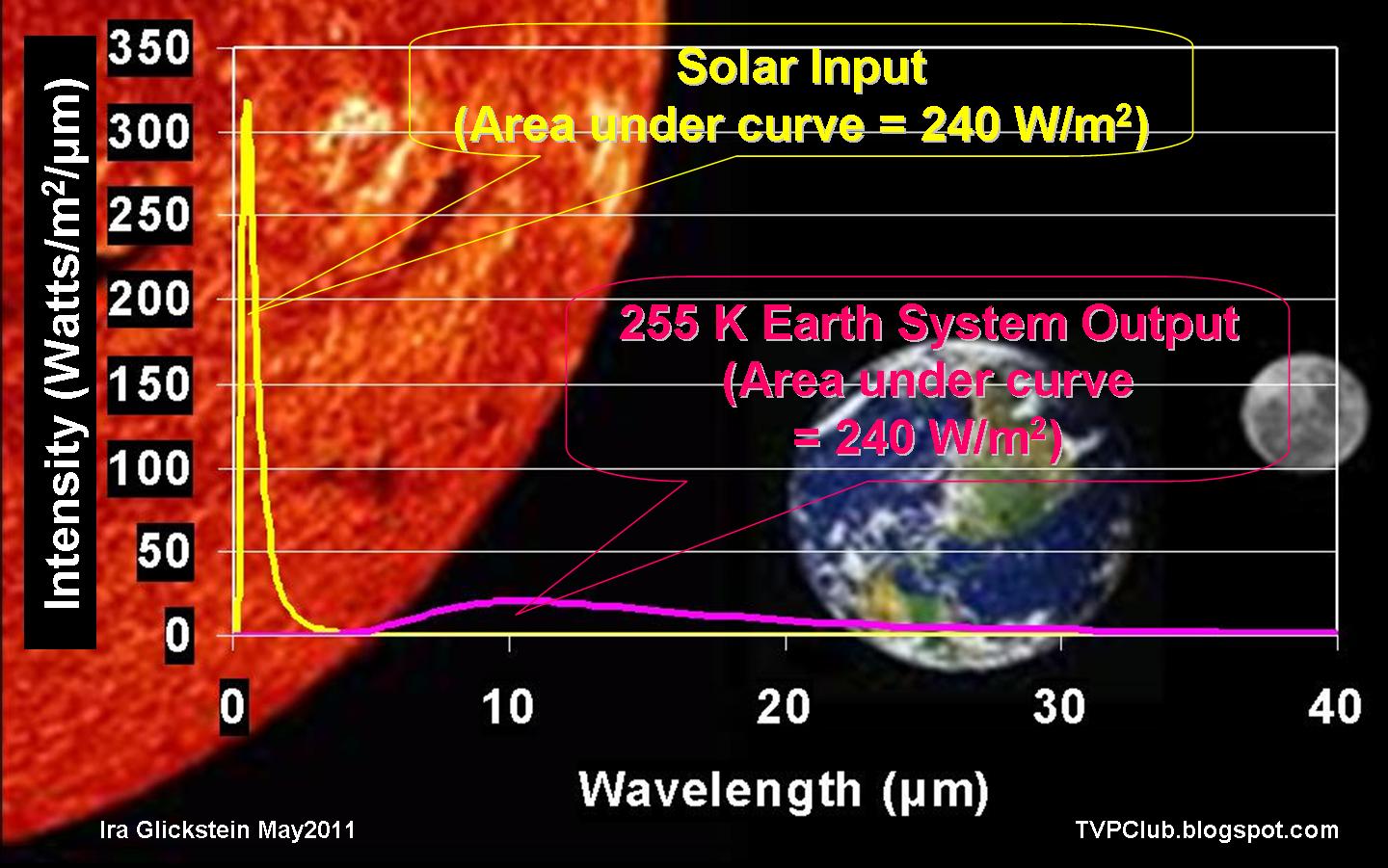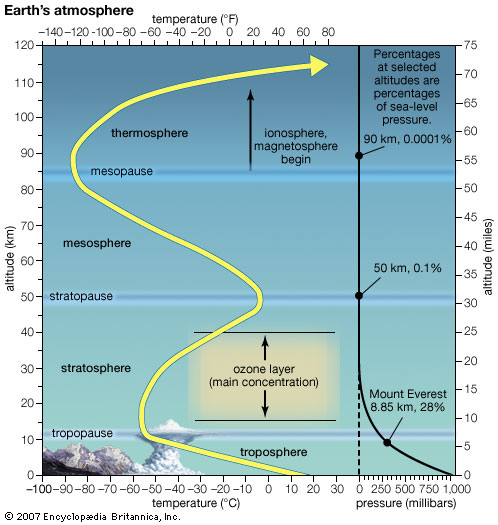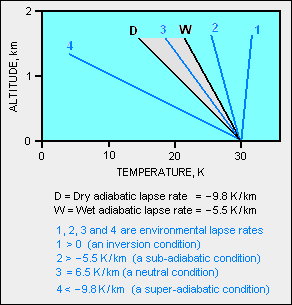The latest is a forthcoming series of articles at the Swedish climate skeptic site Stockholm's Initiative, the first chapter of which is below [Google translation + editing]. These concepts have been discussed in further detail in the series of Hockey Schtick posts on the 'greenhouse equation' and in relation to the Maxwell/Carnot/Clausius atmospheric mass/gravity/pressure theory of the 33K greenhouse effect.
The atmosphere from inside out
Chapter 1.
So here it is: The sun exposes the soil to shortwave radiation. The annual average value at the "top of the atmosphere" (TOA) is 1366 W / m2 ("the sola constant") calculated on the projected ground disc. The average value over the soil surface, and rotation period 24 hours is 1366/4 = 342 kW / m2.
From the incoming radiation, 30% is reflected (albedo = 0.3) (6% of the atmosphere, 20% of clouds, 4% of the surface). The remainder, 240 W / m2, is absorbed by the atmosphere and the surface. Under the condition of energy balance, the Earth must in turn radiate as much energy.
The sun's electromagnetic spectrum is broadly consistent with the radiation of a black body at 5780 K. 

To balance earth's outgoing radiation, in a first approximation, consider the earth as an ideal black body, at a temperature of 255 K. This is usually called the Earth's effective temperature.
An ideal black body requires perfect heat conduction (uniform temperature) within the body. The Earth is not black. It's not a perfect conductor. The temperature is not uniform. The earth is more like a gray insulator. Correction for this provides an effective radiation temperature is a few degrees cooler, 251.95 K. Let us afford ourselves approximation of Earth's effective temperature:
T eff = 252 K
Mean surface temperature is 288 K and 218 K at the so-called tropopause (11,000 m). Troposphere temperature mean value in the vertical direction (Z) is thus
This temperature is found at 5500 meters above sea level where the pressure is 0.5 atm. This confirms that the troposphere profiles (L, lapse rate) with respect to temperature and pressure is linear, which we already know from other observations. The function T (Z) [temperature as a function of height Z] can be written
T (Z) = L * Z
where L ELR = 6.5 K / km (Environmental lapse rate), the atmosphere observed temperature profile, is an observable characteristic of the troposphere. It is a consequence of atmospheric thermodynamic properties.
Applying a thermodynamic approach and associated conditions in a dry or humidity wise unsaturated ideal gas under adiabatic conditions (no net flow of heat to or from the atmosphere in a steady state), one can expect
L DALR = g / c p
where L DALR = dry adiabatic lapse rate (DALR), g is the gravitational constant and c p the specific heat. Inserting the current values gives L DALR = 9.8 K / km.
For a moisture saturated gas held at the dew point at increasing height (decreasing pressure), there is power from the water's heat of vaporization. In this case (L MALR , moist adiabatic lapse rate) is not L MALR constant over the height of the atmosphere, but is on average L ALR ≈5 K / km. Reduction of temperature with height in the atmosphere in this case is less because heat of vaporization continuously released by condensation.
In general we can say that the atmosphere observed temperature profile is a consequence of the fundamental thermodynamic conditions, ie atmospheric internal energy constants when the potential energy increases in the gravitational field.
Observed value at lapse rate L ELR = 6.5 K / m2 located in the interval between the two idealized extremes, L March and L DALR . For a hypothetical dry soil with the same effective temperature Teff = 252 K, which is our real earth, one can account with the above reasoning to expect a temperature at sea level at 306 K, 18 K higher than the observed 288 C (252 F + 9.8 K / km x 5.5 km = 306 K). The dry earth L DARL offset and balanced by a heat transfer (cooling) corresponding to 9.8 to 6.5 = 3.3 K / km in the real atmosphere.
The earth's surface and the atmosphere is heated by solar radiation and thus arises a steady state (constant heat content, constant energy flow), sustained by the radiation balance. Included in this condition is of course all internal heat transfer (absorption, emission, conduction, convection, phase transition), which can balance the L adrl that sets the upper limit of the temperature profile. The surface temperature T 0 = 288 K is 35 K above T eff and 17 K lower than the L ADLR , reflecting the balance between the pressure-dependent warming and the cooling chain of heat transfer by conduction, evaporation, convection and condensation, complete with radiation to space.
So far so good! I am convinced that it is possible to find numerous errors, logical gaps and inconsistencies in the above. I am grateful for all the help locating such holes to see if it is possible to fill them. But so far no trace of any greenhouse or re-radiation. We'll see how it goes in the next two chapters will deal with the albedo, the hydrological cycle, the tropopause, discussion of the possible structure of the atmosphere thermostat (the balance between different paths for heat transfer from a control engineering perspective), entropy and other properties of stationary thermodynamic systems far from equilibrium, and the characteristics of other planets atmospheres. Chapter 2, I have promised the editors to report next Friday 27.2.



Good to see.
ReplyDeleteA minor quibble is that one can still regard the effect of atmospheric mass and gravity as a greenhouse effect, just not a radiative greenhouse effect.
Adiabatically warming descending air dissipates clouds for a more transparent atmosphere, just like the greenhouse glass roof.
Adiabatically warming descending air suppresses or prevents upward convection from below, just as does the greenhouse glass roof.
"discussion of the possible structure of the atmosphere thermostat (the balance between different paths for heat transfer from a control engineering perspective"
ReplyDeleteI think you will find that convection up and down holds the balance between conduction and radiation within the system.
If radiation to space from within an atmosphere increases then radiation to space from the surface decreases and vice versa.
The regulator is the varying amount of energy returning to the surface as heat (from potential energy) within adiabatic descent.